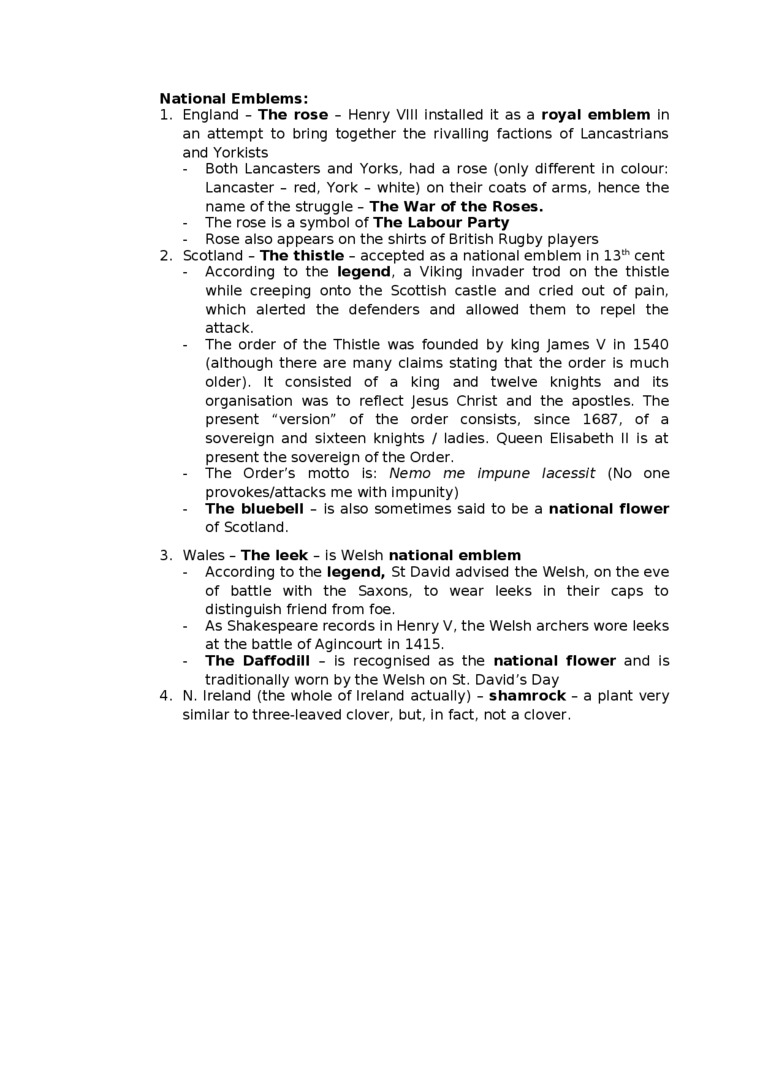91549

National Emblems:
1. England - The rosę - Henry VIII installed It as a royal emblem In
an attempt to bring together the rlvalling factions of Lancastrians
and Yorkists
- Both Lancasters and Yorks, had a rosę (only different In colour: Lancaster - red, York - white) on their coats of arms, hence the name of the struggle - The War of the Roses.
- The rosę is a symbol of The Labour Party
- Rosę also appears on the shirts of British Rugby players
2. Scotland - The thistle - accepted as a national emblem In 13th cent
- According to the legend, a Vlking invader trod on the thistle while creeplng onto the Scottlsh castle and crled out of pain, which alerted the defenders and allowed them to repel the attack.
- The order of the Thistle was founded by king James V In 1540 (although there are many claims stating that the order is much older). It consisted of a king and twelve knights and its organisation was to reflect Jesus Christ and the apostles. The present "version" of the order conslsts, sińce 1687, of a sovereign and sixteen knights / ladies. Queen Elisabeth II is at present the sovereign of the Order.
- The Order's motto is: Nemo me impune lacessit (No one provokes/attacks me with impunity)
- The bluebell - is also sometimes said to be a national flower of Scotland.
3. Wales - The leek - Is Welsh national emblem
- According to the legend, St David advised the Welsh, on the eve of battle with the Saxons, to wear leeks in their caps to distinguish friend from foe.
- As Shakespeare records in Henry V, the Welsh archers wore leeks at the battle of Agincourt in 1415.
- The Daffodill - is recognised as the national flower and is
traditionally worn by the Welsh on St. David's Day
4. N. Ireland (the whole of Ireland actually) - Shamrock - a plant very
similar to three-leaved clover, but, in fact, not a clover.
Wyszukiwarka
Podobne podstrony:
Starting MySQL as a Windows Service On Windows, the recommended way to run MySQL is to install it as
My name will be great among the nations, froin where the sun rises to where it sets,” says the
The Glorious Revolution in England - The Glorious Revolution ( glorious because i
skanuj0018 (186) B* 6. An area at the side of a road where drivers &nbs
htdctmw 013 When you re up above the scene, looking down at it, as in this panel, what else cou
FLINT MINING OF CENTRAL EUROPE 7 meration in the earth crust could bc rccognizcd as a de-posit. In p
The Great Seal It is the national emblem of the United States, adopted on 20“ June 1782 by resoluti
284 United Nations — Treaty Series 1972 the Minister of Agriculture, the Minister of Finance, a
65 loan word K In the Atharva-Veda (VIII, 6) the Gandharvas bray like asses, and as the donkey is a
IMG 61 MM C. Henry, The Porter model oj competilloe adoantage for Inner-city dntelopmenl:
iThe manner of easing the lockdown has been gradual for all EU5 nations to minimise the risk of seco
więcej podobnych podstron